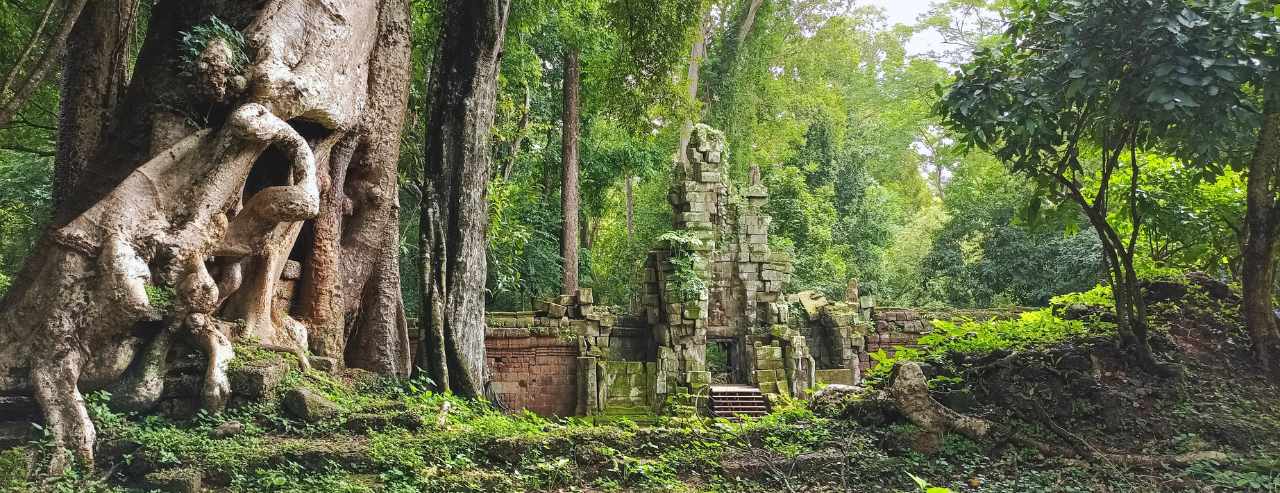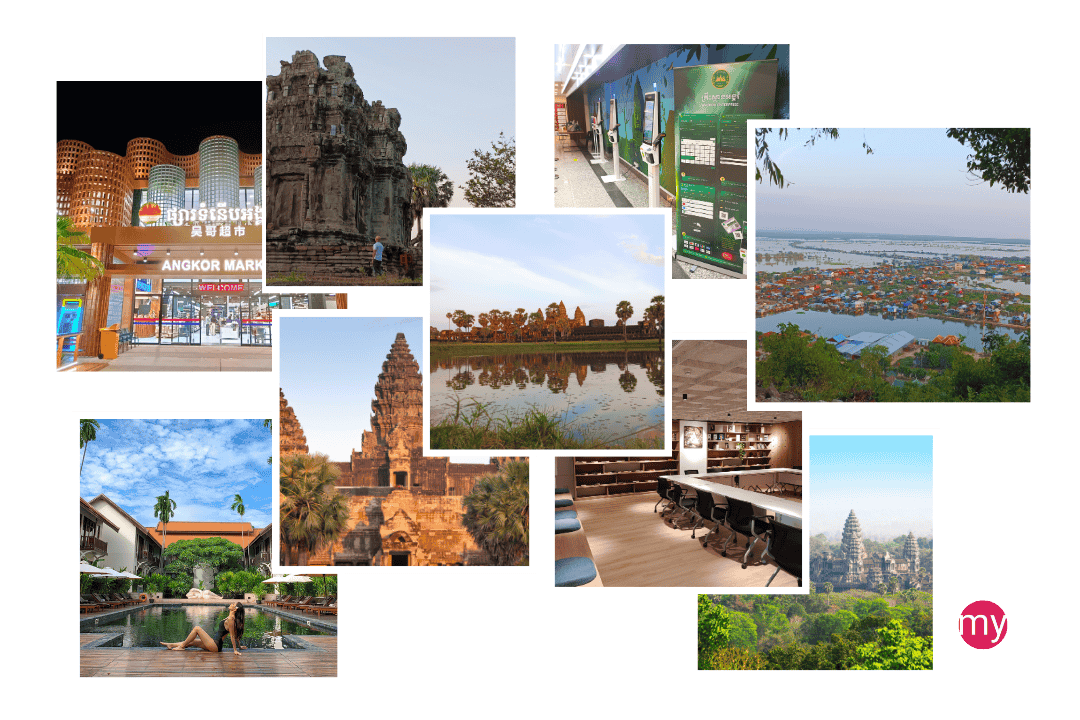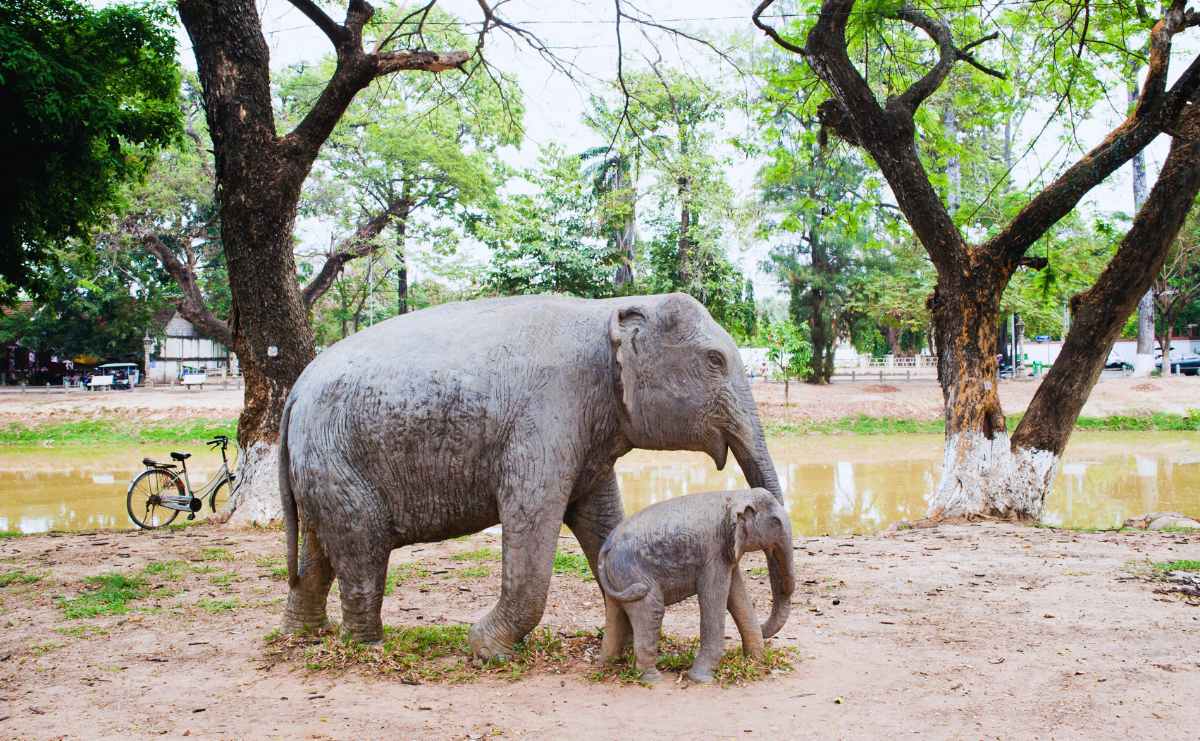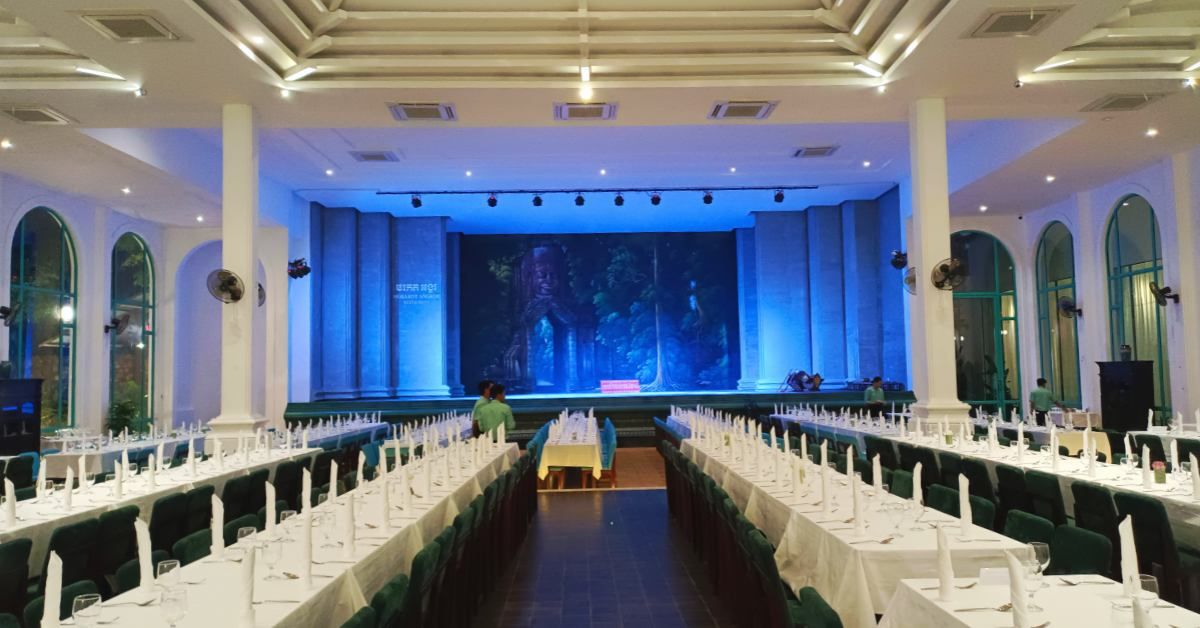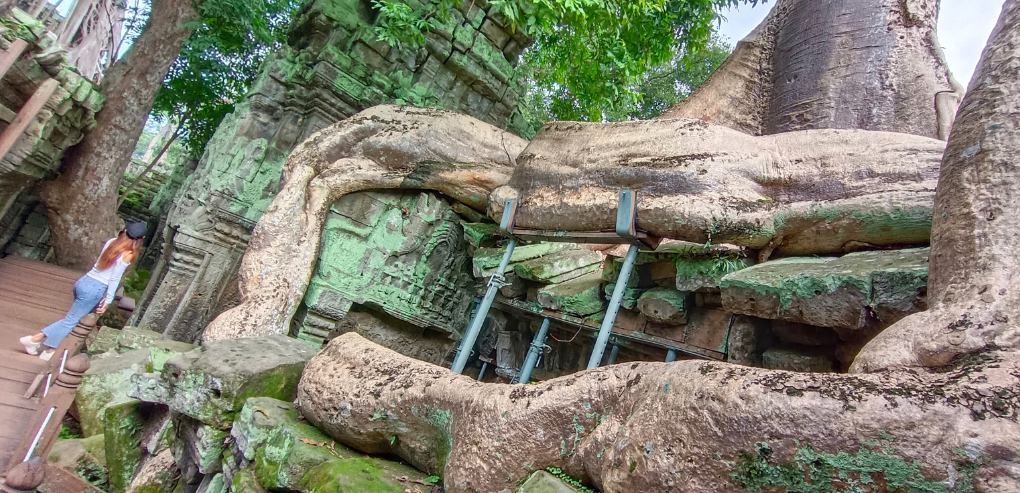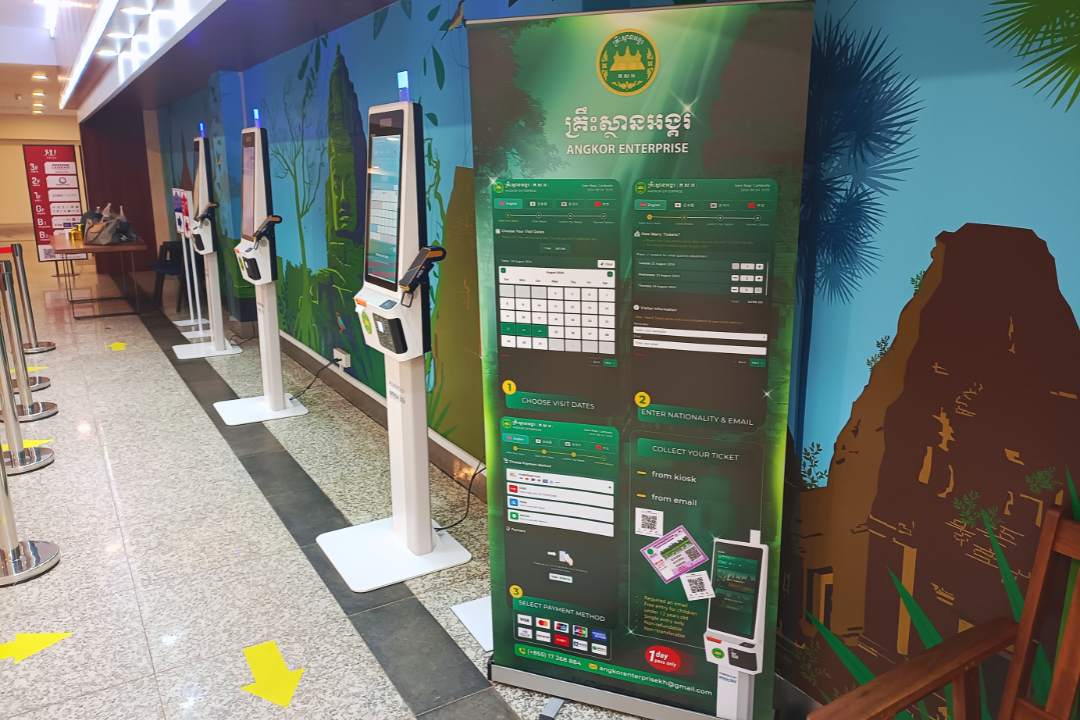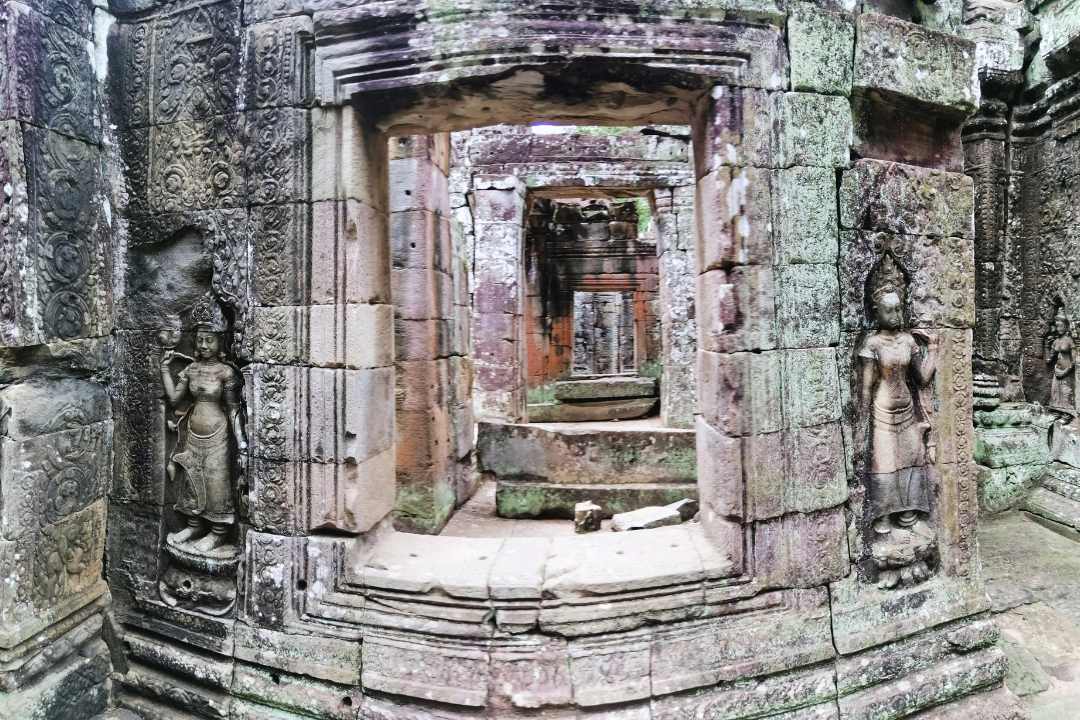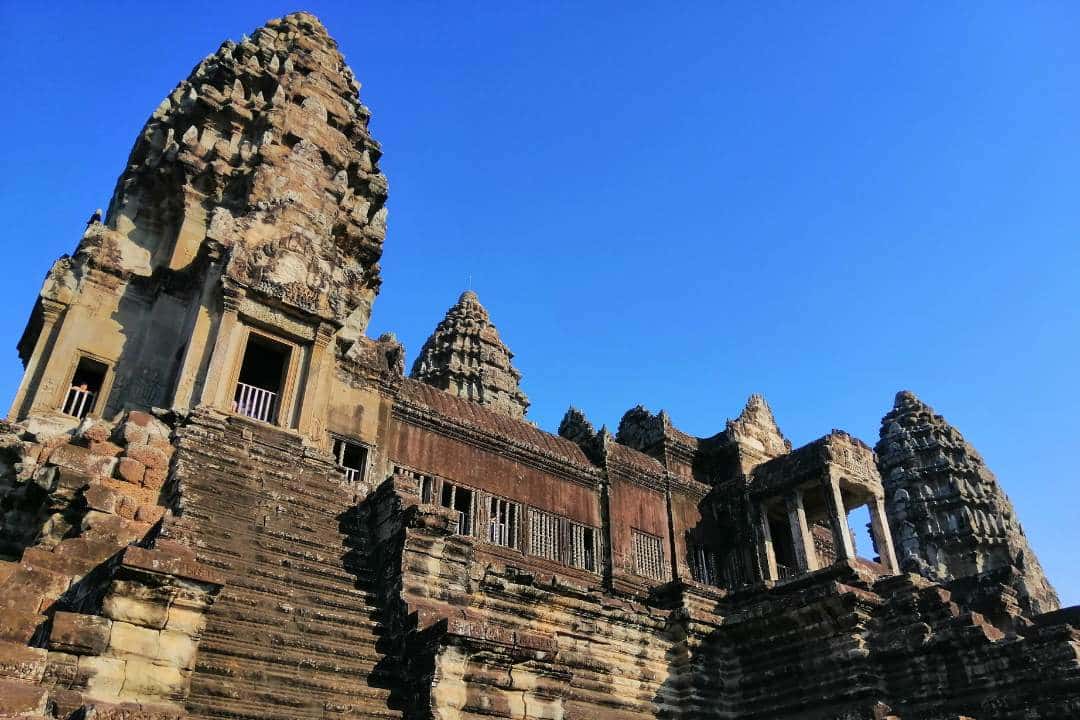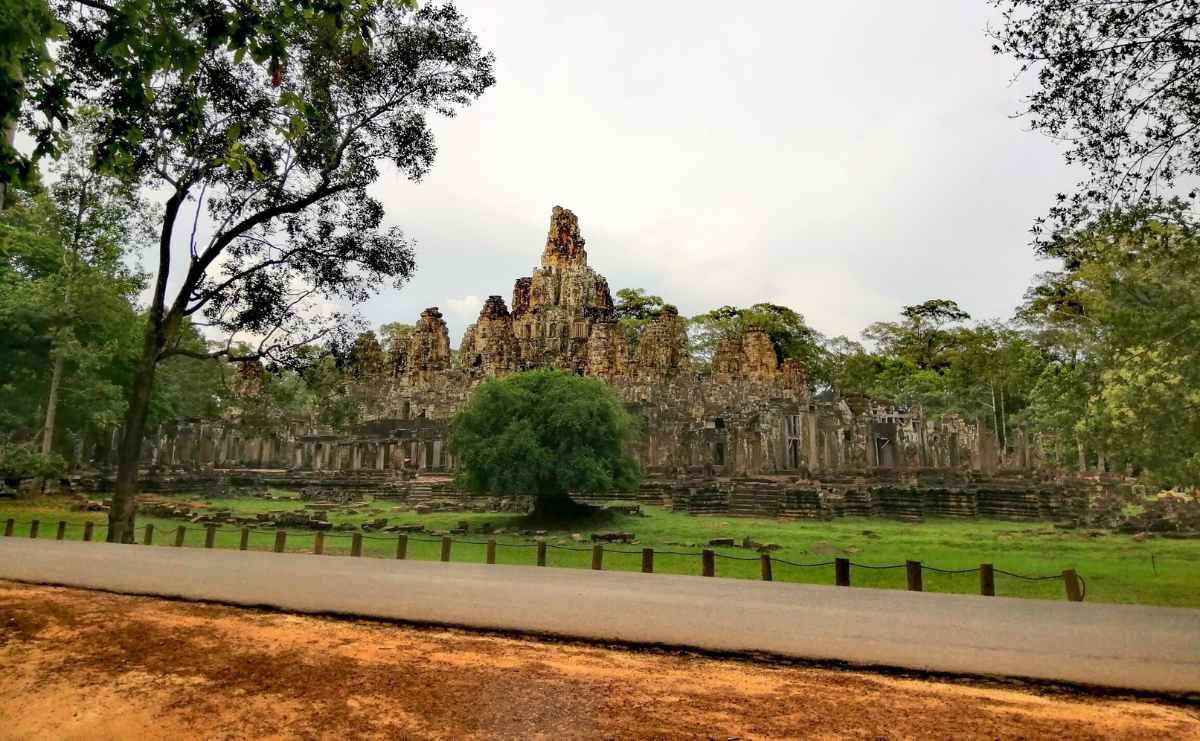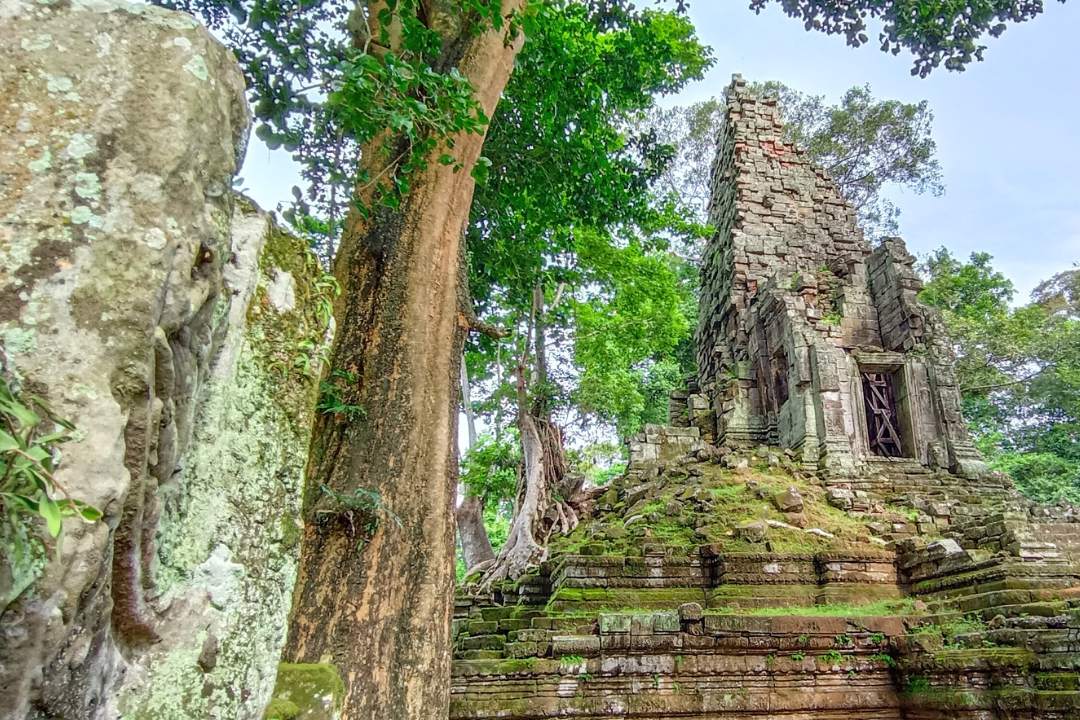Ta Prohm vs Bayon Temple: Which Angkor Icon Deserves Your Time?
One temple gives you tree roots eating ancient stone alive. The other shows 216 giant faces watching your every move. Most visitors waste their ONLY chance picking wrong—here's how to avoid their $37 mistake and see the temple that actually matches what YOU came to Cambodia for.
Ta Prohm vs Bayon Temple isn’t about picking a winner—it’s about understanding two completely different Angkor experiences. Ta Prohm captivates with massive tree roots consuming ancient stone, creating the jungle-swallowed aesthetic that made it the “Tomb Raider temple,” while Bayon mesmerizes with 216 serene stone faces and intricate bas-relief carvings revealing 12th-century Khmer life.
Most travelers visit Ta Prohm and Bayon Temple in a single day, but timing matters: hit Ta Prohm during early morning or late afternoon for dramatic lighting, and catch Bayon at sunrise when the faces emerge from dawn’s glow.
If you’re deciding on Ta Prohm vs Bayon Temple for a limited itinerary, choose Ta Prohm for photography and atmospheric drama, or Bayon for historical depth and artistic mastery—but honestly, both deserve your time. This guide breaks down the architecture, history, best visiting times, and practical tips to help you experience these iconic temples at their absolute best.
What Makes Ta Prohm and Bayon Temple Different?
Let’s cut through the confusion right away. Ta Prohm vs Bayon Temple isn’t about picking a “winner.” It’s about understanding what kind of experience moves you.
Ta Prohm earned fame as the “Tomb Raider temple” after Angelina Jolie’s film brought its jungle-consumed corridors to global audiences. The temple’s defining feature? Enormous Tetrameles nudiflora and silk-cotton trees whose roots cascade over walls like frozen waterfalls. Archaeologists intentionally left Ta Prohm partially unrestored to show what centuries of abandonment can do.
Bayon Temple sits at the heart of Angkor Thom, the last great capital of the Khmer Empire. King Jayavarman VII built this Buddhist temple around 1200 CE, and its 54 towers each display four giant faces. Scholars debate whether they represent Buddha, the king himself, or the bodhisattva Avalokiteshvara. Walking through Bayon feels like being watched by benevolent stone guardians from every direction.
Here’s the practical breakdown:
Ta Prohm Highlights:
- Famous tree root formations merging with stone structures
- Atmospheric jungle setting creating dramatic photo opportunities
- Relatively compact layout (one main level to visit)
- Best visited in early morning or late afternoon for softer light
- Part of Angkor’s small circuit tour route
Bayon Temple Highlights:
- 216 massive stone faces gazing in all directions
- Detailed bas-relief carvings depicting daily Khmer life and historical battles
- Multi-level structure with steep staircases leading to central towers
- Located in Angkor Thom, surrounded by other temples worth seeing
- Requires more time to appreciate detailed carvings and multiple levels
Ta Prohm vs Bayon Differences: The Experience Factor
Now for the practical comparison every traveler needs. These Ta Prohm vs Bayon differences will help you allocate your time:
Atmospheric Experience:
- Ta Prohm: Jungle adventure, nature reclaiming civilization, photogenic drama
- Bayon: Spiritual contemplation, artistic appreciation, architectural grandeur
Physical Demands:
- Ta Prohm: Mostly flat, uneven ground, some climbing over roots
- Bayon: Steep staircases, multiple levels, more strenuous walking
Time Investment:
- Ta Prohm: 45-60 minutes for casual visit, 90 minutes for thorough exploration
- Bayon: 60-90 minutes minimum, 2+ hours to appreciate all carvings and levels
Photography Opportunities:
- Ta Prohm: Tree roots, jungle atmosphere, natural drama, limited good angles
- Bayon: Face towers, detailed carvings, sunrise/sunset options, 360-degree shots
Crowd Management:
- Ta Prohm: Can get packed mid-morning (tour groups follow similar schedules)
- Bayon: Larger area distributes crowds better, but central platform gets congested
Educational Content:
- Ta Prohm: Shows nature’s power, conservation work, archaeology decisions
- Bayon: Shows Khmer daily life, religious transitions, artistic achievement, military history
Ta Prohm History: When Jungle Reclaims Human Achievement
Built in 1186 CE by King Jayavarman VII, Ta Prohm served as a Mahayana Buddhist monastery and university. Historical inscriptions show the temple once housed 12,640 people, including 18 high priests and 615 dancers. The compound required 79,365 support personnel in surrounding villages to maintain operations.
The Ta Prohm history took a dramatic turn after the Khmer Empire’s decline in the 15th century. Unlike other Angkor temples that received ongoing maintenance, Ta Prohm fell into abandonment. Seeds from fig and silk-cotton trees took root in cracks and crevices. Over centuries, these grew into the massive trees you see today, their roots simultaneously destroying and holding together the ancient stones.
French archaeologists who surveyed Angkor in the late 19th century faced a choice: restore Ta Prohm completely or preserve its haunting fusion of nature and construction. They chose the latter, and later restoration efforts by the Archaeological Survey of India (1995-2004) focused on stabilization rather than removal of the trees.
This decision created one of Ta Prohm’s most photogenic spots: the iconic tree-covered corridor where roots drape over doorways like organic curtains. It’s the visual that dominates Instagram feeds and travel brochures worldwide.
Best Time to Visit Ta Prohm and Bayon Temple
Timing your visit to these Khmer Empire temples makes the difference between a mediocre and memorable experience.
Ta Prohm works best at:
- Early morning (7:00-8:30 AM): Fewer crowds, softer light filtering through trees, cooler temperatures
- Late afternoon (3:30-5:00 PM): Golden hour light creates dramatic shadows through root systems
- Avoid: 9:00 AM-2:00 PM when tour groups converge and harsh overhead sun creates poor lighting
Bayon shines during:
- Sunrise (5:30-7:00 AM): Faces emerge from dawn light, magical atmosphere, minimal crowds
- Mid-morning (8:00-10:00 AM): Good light for photographing bas-reliefs on outer galleries
- Late afternoon (3:00-5:00 PM): Warm light improves sandstone colors, face towers glow
- Avoid: Midday when harsh overhead sun creates deep shadows in galleries
Many travelers visit both temples in a single day as part of the small circuit route. The standard itinerary visits Angkor Wat for sunrise, then proceeds to Bayon mid-morning, and Ta Prohm before lunch. This schedule means you’ll encounter crowds at both locations.
For a better experience, consider splitting them across different days or hiring a local guide who can adjust timing based on real-time crowd patterns.
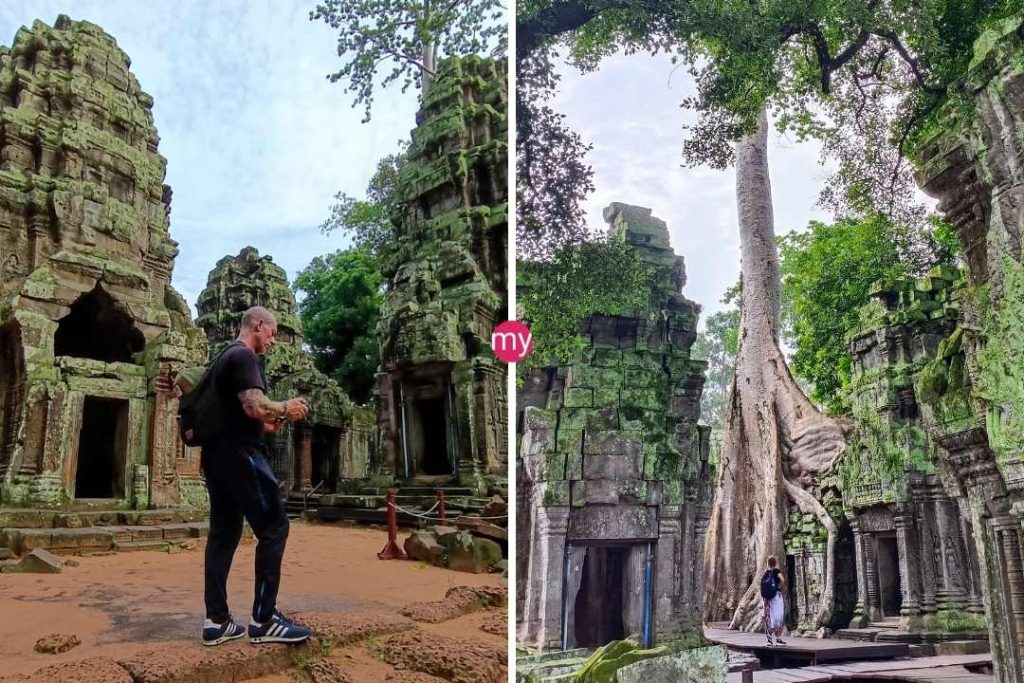
Bayon Temple History: The Smiling Faces of a King
Bayon Temple history reflects a different chapter in Khmer building styles. King Jayavarman VII constructed Bayon in the late 12th to early 13th century as the state temple of his capital, Angkor Thom. Unlike earlier Hindu temples at Angkor, Bayon honored Buddhism (Mahayana Buddhism that emphasized compassion and universal salvation).
The temple’s design follows a mandala pattern representing the universe. Its most distinctive feature (those serene Bayon Temple faces) likely depicts Avalokiteshvara, the bodhisattva of compassion. Some historians argue the faces combine Buddha’s features with Jayavarman VII’s own appearance, creating a statement of both political and religious power.
The Bayon carvings covering the temple’s galleries tell two types of stories. The outer gallery depicts historical events: battles with the Cham people, naval warfare on Tonle Sap Lake, and the construction of Angkor Thom itself. Inner galleries show Hindu mythology and daily life in 13th-century Cambodia (market scenes, cockfights, childbirth, and festivals).
After Jayavarman VII’s death, subsequent Hindu kings modified Bayon by adding Hindu imagery and covering some Buddhist elements. This layered history makes Bayon a palimpsest of Khmer Empire temples, where different religious traditions left their marks on the same stone.
Watch Dawn Break Over Ancient Wonders
Start your day with magic as the sun rises over Angkor Wat’s towers, painting the sky in gold and crimson. This customizable full-day journey lets YOU choose which temples speak to your soul. With a coffee break after sunrise, a traditional Lok Lak lunch, and your expert guide capturing those perfect photos, this 11-hour experience brings ancient Cambodia to life. Pick from four unique routes and create memories that last forever.
Ta Prohm Architecture: Where Stone Surrenders to Roots
Ta Prohm architecture follows the flat, single-story plan typical of Khmer monastery temples. Five rectangular enclosing walls once defined separate precincts, though much of the outer walls have crumbled. The temple covers about 650,000 square meters, though most of that was occupied by living quarters that have since disappeared.
The central sanctuary sits within several concentric galleries connected by passageways. These corridors create a labyrinthine quality. You’ll find yourself circling back to areas you thought you’d already seen. This maze-like layout works to Ta Prohm’s advantage, making the temple feel larger and more mysterious than its actual footprint.
What sets Ta Prohm apart from other Angkor Wat complex temples isn’t the original design but what happened after abandonment. The Ta Prohm tree roots you see today have become structural elements. Remove the trees now, and entire walls would collapse. The roots spread across stones like arthritic fingers, gripping sandstone blocks in positions they no longer occupy naturally.
The most famous spot features a Tetrameles nudiflora tree whose roots cascade over the eastern entrance like a waterfall of wood. Photography tour groups line up here throughout the day. For less crowded Ta Prohm photogenic spots, check the western galleries where smaller trees create equally dramatic compositions.
Bayon Temple Layout: A Universe in Stone
The Bayon temple layout reflects a more vertical ambition than Ta Prohm. Three levels rise to a central tower 43 meters high. The base measures 140 by 160 meters, smaller than Angkor Wat but packed with artistic detail.
The first level contains the famous bas-relief galleries stretching over 1,200 meters. These Bayon carvings required thousands of artisans working over decades. The outer wall depicts military campaigns and historical events with detail you won’t believe. You can identify individual weapons, observe military tactics, and even spot Chinese merchants in crowd scenes.
The second level features smaller chambers that once held Buddha statues (most removed or defaced during later Hindu revivals). The third level (the central massif) contains 16 towers arranged around a 43-meter central peak. This is where you’ll find yourself surrounded by those faces gazing in the cardinal directions.
Climbing Bayon requires navigating steep staircases with steps as narrow as 10 centimeters. If mobility concerns you, you can appreciate much of the temple from the first level, though you’ll miss the intimate encounter with the face towers.
The Angkor Thom temples surrounding Bayon (Baphuon, Phimeanakas, the Terrace of the Elephants) make this area a full morning or afternoon commitment. Most visitors combine Bayon with these nearby structures rather than visiting it alone.
Float Through Time on Water
Step into a world where life flows with the river on this Kampong Phluk morning tour. Glide past stilted houses rising 8 meters high, paddle through enchanted mangrove forests in traditional canoes, and meet families who’ve mastered life on Tonle Sap Lake for generations. This 6-hour journey captures golden morning light, authentic village culture, and the peaceful rhythm of Cambodia’s floating communities.

Get Lost in the Jungle Temple
Channel your inner explorer at Beng Mealea, where massive trees reclaim ancient stone and nature writes its own story. This full-day adventure combines four majestic temples with a sunset hike up Phnom Bok, butterflies dancing at Banteay Srey center, and the intricate pink sandstone carvings of Banteay Srei. Ten hours of Indiana Jones-style discovery, ending with golden hour views over the Cambodian countryside.
Bayon Temple Carvings: Reading Stone Stories
The Bayon carvings deserve dedicated time if you’re interested in Khmer history beyond Instagram photos. The outer gallery’s bas-reliefs function as a visual encyclopedia of 12th-century Cambodian life.
On the south gallery’s eastern section, you’ll find depictions of the Khmer-Cham naval battle of 1177. Look for:
- Detailed war canoes with multiple rowers
- Armed soldiers with distinctive helmets identifying their ethnicity
- Dead bodies floating in water (represented by fish eating corpses)
- Commanders standing under parasols directing troops
The western section of the south gallery shows daily life: a woman giving birth attended by midwives, a market scene with vendors and customers, men gambling, and a cockfight with spectators placing bets. These mundane scenes provide historians with information about ordinary Khmer society that you won’t find anywhere else.
The east gallery’s southern section depicts a royal procession with King Jayavarman VII riding a war elephant, surrounded by attendants holding parasols and fans. The detail extends to the elephant’s harness decoration and the expressions on people’s faces.
Many visitors walk past these Bayon carvings without realizing they’re looking at a stone documentary of medieval Southeast Asia. A knowledgeable tour guide can spend hours decoding these galleries.
Planning Your Angkor Temple Comparisons Visit
If you’re doing serious Angkor temple comparisons, here’s how to structure your experience:
For First-Time Visitors (Limited Time): Both temples qualify as “must-see” destinations. If you can only choose one:
- Choose Ta Prohm if you prioritize photography, dramatic visuals, and the nature-versus-building theme
- Choose Bayon if you want historical detail, artistic achievement, and to understand Khmer civilization
For Thorough Explorers (Multiple Days): Visit both, but on different days with different timing:
- Day 1: Bayon at sunrise (spectacular), then nearby Angkor Thom temples
- Day 2: Ta Prohm mid-afternoon as part of the small circuit
- This schedule lets you experience each temple at its best time
With a Guide or Solo?
- Ta Prohm works fine independently (the visuals speak for themselves)
- Bayon benefits from expert interpretation (the carvings contain stories you’ll miss alone)
Consider joining a private Angkor Wat tour that includes both temples with flexible timing based on your interests. Local guides familiar with crowd patterns can adjust your itinerary to avoid the worst congestion.
Beyond the Famous Two: Other Cambodia Ancient Temples
Your Angkor experience shouldn’t end with Ta Prohm vs Bayon Temple comparisons. The park contains dozens of worthwhile sites:
Similar to Ta Prohm:
- Beng Mealea: A larger, more remote temple equally consumed by jungle, with fewer crowds
- Preah Khan: Another tree-covered temple with a more intact layout and less tourist infrastructure
Similar to Bayon:
- Angkor Wat: The ultimate achievement of Khmer building, larger and more refined than Bayon
- Baphuon: A pyramid temple within Angkor Thom featuring a massive reclining Buddha
Completely Different Experiences:
- Banteay Srei: Small temple famous for pink sandstone carvings
- Koh Ker: Remote pyramid temple rising 36 meters above the jungle
- Roluos Group: Earlier temples showing the evolution toward Angkor’s building style
Most travelers spend 3-4 days exploring Angkor Archaeological Park. This allows time for the major temples without exhausting yourself. A 2-day Angkor experience covers the main sites at a comfortable pace.
Practical Tips for Visiting Both Temples
Tickets and Access: You’ll need an Angkor Archaeological Park pass covering both temples. Options include:
- 1-day pass: $37 (good for visiting both temples in one day)
- 3-day pass: $62 (can be used over a week, better price)
- Purchase at the Angkor ticket office or buy Angkor pass online before your visit
What to Wear: Both are active religious sites with dress codes:
- Cover shoulders (no tank tops or sleeveless shirts)
- Cover knees (no short shorts or skirts above the knee)
- Comfortable walking shoes (sandals acceptable but sneakers better for climbing)
- Hat and sunscreen (limited shade, especially at Bayon)
What to Bring:
- Water (at least 1 liter per person, more in hot season)
- Small flashlight (useful in darker Ta Prohm corridors)
- Camera with backup battery (you’ll take more photos than you expect)
- Small bills for temple donation boxes (optional but appreciated)
Transportation Between Temples: Ta Prohm and Bayon Temple sit about 2.5 kilometers apart. Options:
- Tuk-tuk with driver (most common, $15-20 for full-day charter)
- Private car with A/C ($30-40 full day)
- Bicycle rental (adventurous but exhausting in heat)
- E-bike rental (good middle ground, growing in popularity)
Most visitors hire a tuk-tuk driver for a full-day temple circuit. This provides flexibility to adjust your schedule and rest between sites. Drivers wait at each temple rather than leaving you to arrange pickup.
Photography Guide: Capturing Ta Prohm and Bayon
These temples offer different photographic opportunities.
Ta Prohm Photography Tips:
- The famous tree-covered entrance gets crowded. Arrive early or wait for gaps in foot traffic
- Shoot in aperture priority mode (f/5.6-f/8) to keep both roots and background in focus
- Look for light shafts penetrating the canopy (early morning offers best chances)
- Check western galleries for less-photographed root formations
- Try vertical compositions emphasizing how roots cascade down walls
- Overcast days work better here than harsh sun (softer, even light)
Bayon Photography Tips:
- The central platform offers 360-degree face tower shots at sunrise and sunset
- Use a wide-angle lens (16-35mm) to capture multiple faces in one frame
- Photograph bas-reliefs from an angle to show the depth of carving
- Mid-morning side light brings out relief detail better than overhead sun
- Climb to the upper level for eye-level face tower portraits
- Black and white conversion works beautifully for the stone faces
Both temples allow tripods, though carrying one through crowds gets cumbersome. A monopod offers a good compromise for stability without the bulk.
Two Perfect Days in Angkor’s Kingdom
Can’t decide which temples to see? This complete 2-day experience solves that dilemma beautifully.
Day one brings you Angkor Wat at sunrise, the enigmatic faces of Bayon, and Ta Prohm’s tree-wrapped galleries.
Day two takes you to Banteay Srei’s intricate pink carvings, the remote grandeur of Banteay Samre, and Pre Rup temple for sunset views. With comfortable pacing, expert guides, and all the iconic sites covered, this is your perfect introduction to the Angkor Archaeological Park.
The Verdict: Ta Prohm vs Bayon Temple
So which temple “wins” the Ta Prohm vs Bayon Temple debate? That’s the wrong question. They represent different things that make Angkor amazing.
Ta Prohm shows you nature’s power. How human achievement, no matter how grand, eventually succumbs to organic forces. It’s romantic, photogenic, and emotionally stirring. You’ll leave with dramatic photos and a visceral sense of time’s passage.
Bayon shows human achievement at its peak. Artistic mastery, religious devotion, and political power expressed in stone. It’s intellectually rich, historically interesting, and spiritually moving. You’ll leave understanding Khmer civilization in ways no book can teach.
If your schedule forces a choice, consider:
- Choose Ta Prohm if you have limited mobility (mostly flat, easier access)
- Choose Bayon if you love history and art (richer educational experience)
- Choose Ta Prohm if photography drives your travel (more instantly dramatic shots)
- Choose Bayon if you want to understand the Khmer Empire temples (more historical context)
But honestly? Don’t choose. Visit both. These temples work best experienced together, showing two sides of Angkor’s story. The contrast between them (one demonstrating building fragility, the other its persistence) creates a complete narrative about human ambition, religious faith, and time’s relentless march.
Frequently Asked Questions
How far is Ta Prohm from Bayon Temple? About 2.5 kilometers (1.5 miles) along the small circuit route. Most visitors combine them in a single morning or afternoon, with tuk-tuk transport taking 5-10 minutes between temples.
Can you visit Ta Prohm and Bayon in one day? Yes. Most one-day Angkor itineraries include both temples plus Angkor Wat and several others. Budget 60-90 minutes at each temple for a satisfying visit without rushing.
Which temple has more tree roots: Ta Prohm or Beng Mealea? Beng Mealea features more tree coverage and feels more “lost in jungle” than Ta Prohm, but lacks Ta Prohm’s carefully preserved iconic root formations. Ta Prohm offers better photography opportunities; Beng Mealea provides a more adventurous experience.
Do I need a guide for these temples? Not required, but highly recommended for Bayon. The bas-relief galleries contain stories you’ll miss without expert interpretation. Ta Prohm’s visual appeal works well for independent visits, though a guide adds historical context.
What’s the best small circuit tour order? The standard route goes: Angkor Wat → Angkor Thom/Bayon → Ta Prohm → Ta Keo → other small circuit temples. This follows a logical geographic path. But reversing the order (starting at Ta Prohm) can help you avoid crowds.
Are the stairs at these temples difficult? Ta Prohm is mostly flat with minimal climbing. Bayon features steep staircases to reach upper levels. If you have mobility concerns, you can appreciate the bas-reliefs and lower level without climbing. The central platform stairs have near-vertical sections with narrow steps.
Ready to experience these iconic temples? Check out My Siem Reap Tours for expert-guided experiences that let you skip the crowds and see both Ta Prohm and Bayon at their best. From sunrise tours at Angkor Wat to customized temple itineraries, local guides who know these stones intimately will transform your visit from a photo stop to a real connection with Khmer history.
Your Angkor adventure shouldn’t be about choosing between temples. It should be about experiencing them all at their best moments, with insights that bring ancient stones to life.
Brought to you by Dan and Mat, Your tour planners.
Featured
Explore more on My Siem Reap Tours
Koh Ker and Beng Mealea guided tour | Banteay Srei temple guided tour | Angkor Wat Sunrise tour | Private Angkor Wat Sunset Tour | Koh Ker and Beng Mealea guided tour | Morning Siem Reap floating village tour | Afternoon Siem Reap floating village tour | Private Angkor Wat special tour | Kulen Waterfall small group guided Tour | Private Angkor Wat mix temples photo tour
